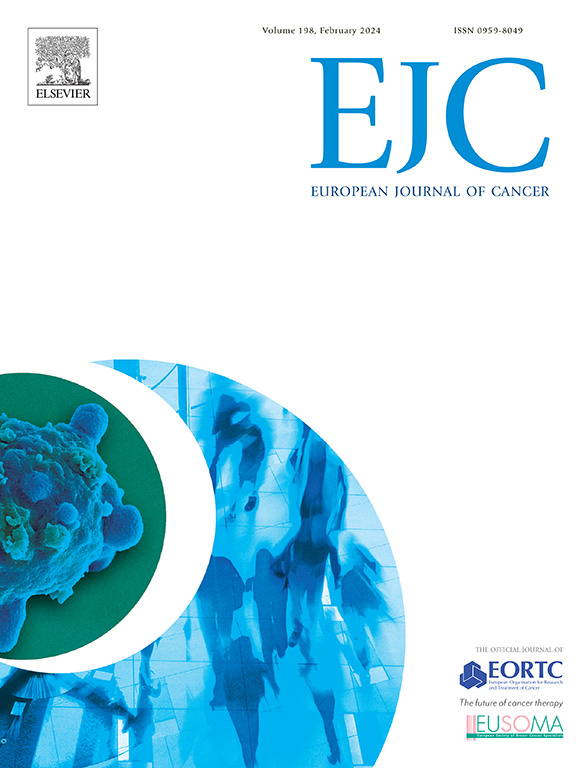The association between pretreatment emotional distress and response to tumor-infiltrating lymphocyte therapy in advanced melanoma
IF 7.6
1区 医学
Q1 ONCOLOGY
引用次数: 0
Abstract
Aims
Adoptive cell therapy (ACT) using tumor-infiltrating lymphocytes (TILs) has demonstrated benefit for patients with advanced melanoma refractory to first-line immune checkpoint inhibitors (ICIs). However, predictive biomarkers for TIL therapy response are limited. Preclinical studies suggest that emotional distress (ED) may impair antitumor immune responses. We conducted a post-hoc analysis of the phase III TIL trial (NCT02278887) to evaluate the association between pretreatment ED and TIL therapy outcomes.
Methods
ED was evaluated using a composite score derived from the Impact of Event Scale and the emotional functioning subscale of the EORTC QLQ-C15-PAL. Patients were stratified into elevated ED (n = 32) or normal ED (n = 40) groups using a median split approach. To evaluate whether the obtained results were dependent on the ED classification method, a sensitivity analysis was conducted to compare TIL therapy outcomes between patients with composite ED scores in the lowest tertile (normal ED, n = 26) and highest tertile (elevated ED, n = 25).
Results
Elevated ED was associated with a reduced objective response rate (37 % vs. 69 %; adjusted odds ratio, 0.28; 95 % confidence interval [CI], 0.19–0.75; P = 0.013) and decreased progression-free survival rates at 1-year (31 % vs. 58 %) and 2-years (16 % vs. 35 %; adjusted hazard ratio, 1.84; 95 % CI, 1.03–3.26; P = 0.038). Sensitivity analysis using the tertile grouping method showed a similar trend (odds ratio, 0.35; 95 % CI, 0.11–1.08, P = 0.072).
Conclusion
Our findings suggest that elevated ED before TIL therapy is associated with reduced therapeutic outcomes, underscoring the need for further investigation into the stress-immune-cancer axis.
晚期黑色素瘤患者预处理情绪困扰与肿瘤浸润性淋巴细胞治疗反应的关系
使用肿瘤浸润淋巴细胞(til)的过继细胞疗法(ACT)已被证明对一线免疫检查点抑制剂(ICIs)难治性晚期黑色素瘤患者有益。然而,TIL治疗反应的预测性生物标志物是有限的。临床前研究表明,情绪困扰(ED)可能损害抗肿瘤免疫反应。我们对III期TIL试验(NCT02278887)进行了事后分析,以评估ED预处理与TIL治疗结果之间的关系。方法采用事件影响量表和EORTC QLQ-C15-PAL情绪功能子量表的综合评分进行评价。采用中位数分割法将患者分为ED升高组(n = 32)和ED正常组(n = 40)。为了评估所获得的结果是否依赖于ED分类方法,我们进行了敏感性分析,比较最低分位(ED正常,n = 26)和最高分位(ED升高,n = 25)的ED综合评分患者的TIL治疗结果。结果ED升高与客观有效率降低相关(37 % vs 69 %;调整后优势比为0.28;95 %置信区间[CI], 0.19-0.75;P = 0.013),1年(31 % vs. 58 %)和2年(16 % vs. 35 %)无进展生存率降低;调整后风险比为1.84;95 % ci, 1.03-3.26; = 0.038页)。采用五分位数分组法进行敏感性分析,结果也有类似的趋势(优势比,0.35;95 % ci, 0.11-1.08, p = 0.072)。结论:我们的研究结果表明,TIL治疗前ED升高与治疗效果降低相关,强调了进一步研究应激-免疫-癌症轴的必要性。
本文章由计算机程序翻译,如有差异,请以英文原文为准。
求助全文
约1分钟内获得全文
求助全文
来源期刊

European Journal of Cancer
医学-肿瘤学
CiteScore
11.50
自引率
4.80%
发文量
953
审稿时长
23 days
期刊介绍:
The European Journal of Cancer (EJC) serves as a comprehensive platform integrating preclinical, digital, translational, and clinical research across the spectrum of cancer. From epidemiology, carcinogenesis, and biology to groundbreaking innovations in cancer treatment and patient care, the journal covers a wide array of topics. We publish original research, reviews, previews, editorial comments, and correspondence, fostering dialogue and advancement in the fight against cancer. Join us in our mission to drive progress and improve outcomes in cancer research and patient care.
 求助内容:
求助内容: 应助结果提醒方式:
应助结果提醒方式:


